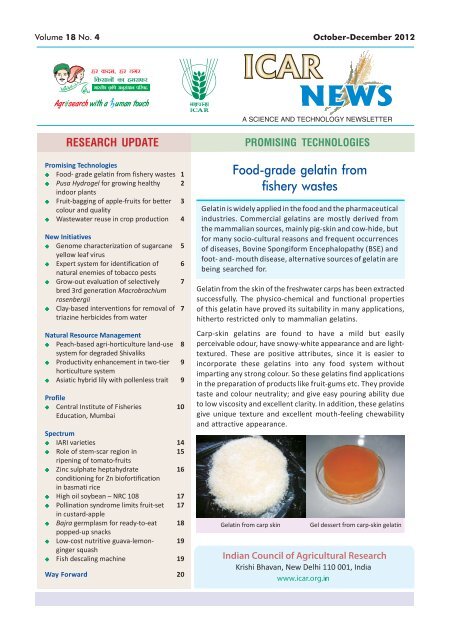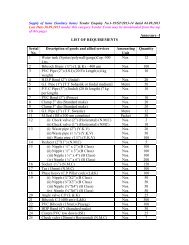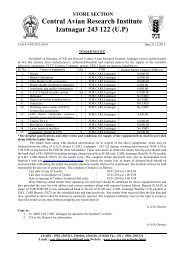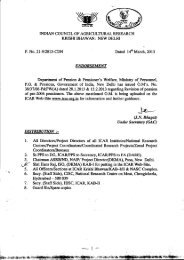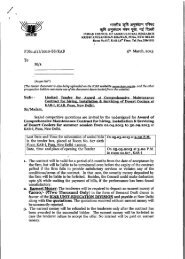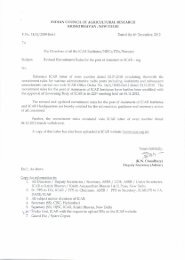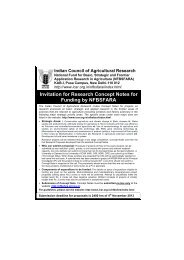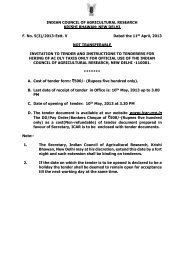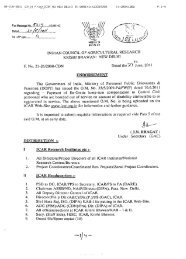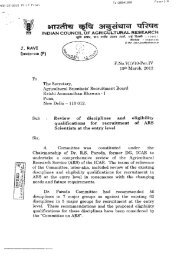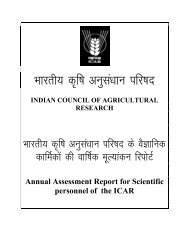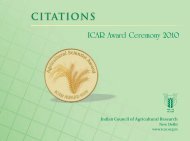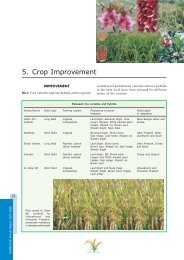Volume 18 no. 4 October- December 2012 - Indian Council of ...
Volume 18 no. 4 October- December 2012 - Indian Council of ...
Volume 18 no. 4 October- December 2012 - Indian Council of ...
You also want an ePaper? Increase the reach of your titles
YUMPU automatically turns print PDFs into web optimized ePapers that Google loves.
<strong>Volume</strong> <strong>18</strong> No. 4 <strong>October</strong>-<strong>December</strong> <strong>2012</strong><br />
Promising Tech<strong>no</strong>logies<br />
Food- grade gelatin from fishery wastes 1<br />
Pusa Hydrogel for growing healthy 2<br />
indoor plants<br />
Fruit-bagging <strong>of</strong> apple-fruits for better 3<br />
colour and quality<br />
Wastewater reuse in crop production 4<br />
New Initiatives<br />
Ge<strong>no</strong>me characterization <strong>of</strong> sugarcane 5<br />
yellow leaf virus<br />
Expert system for identification <strong>of</strong> 6<br />
natural enemies <strong>of</strong> tobacco pests<br />
Grow-out evaluation <strong>of</strong> selectively 7<br />
bred 3rd generation Macrobrachium<br />
rosenbergii<br />
Clay-based interventions for removal <strong>of</strong> 7<br />
triazine herbicides from water<br />
Natural Resource Management<br />
Peach-based agri-horticulture land-use 8<br />
system for degraded Shivaliks<br />
Productivity enhancement in two-tier 9<br />
horticulture system<br />
Asiatic hybrid lily with pollenless trait 9<br />
Pr<strong>of</strong>ile<br />
Central Institute <strong>of</strong> Fisheries 10<br />
Education, Mumbai<br />
Spectrum<br />
IARI varieties 14<br />
Role <strong>of</strong> stem-scar region in<br />
ripening <strong>of</strong> tomato-fruits<br />
15<br />
Zinc sulphate heptahydrate<br />
conditioning for Zn bi<strong>of</strong>ortification<br />
in basmati rice<br />
16<br />
High oil soybean – NRC 108 17<br />
Pollination syndrome limits fruit-set<br />
in custard-apple<br />
17<br />
Bajra germplasm for ready-to-eat<br />
popped-up snacks<br />
<strong>18</strong><br />
Low-cost nutritive guava-lemonginger<br />
squash<br />
19<br />
Fish descaling machine 19<br />
Way Forward 20<br />
Food-grade gelatin from<br />
fishery wastes<br />
Gelatin is widely applied in the food and the pharmaceutical<br />
industries. Commercial gelatins are mostly derived from<br />
the mammalian sources, mainly pig-skin and cow-hide, but<br />
for many socio-cultural reasons and frequent occurrences<br />
<strong>of</strong> diseases, Bovine Spongiform Encephalopathy (BSE) and<br />
foot- and- mouth disease, alternative sources <strong>of</strong> gelatin are<br />
being searched for.<br />
Gelatin from the skin <strong>of</strong> the freshwater carps has been extracted<br />
successfully. The physico-chemical and functional properties<br />
<strong>of</strong> this gelatin have proved its suitability in many applications,<br />
hitherto restricted only to mammalian gelatins.<br />
Carp-skin gelatins are found to have a mild but easily<br />
perceivable odour, have s<strong>no</strong>wy-white appearance and are lighttextured.<br />
These are positive attributes, since it is easier to<br />
incorporate these gelatins into any food system without<br />
imparting any strong colour. So these gelatins find applications<br />
in the preparation <strong>of</strong> products like fruit-gums etc. They provide<br />
taste and colour neutrality; and give easy pouring ability due<br />
to low viscosity and excellent clarity. In addition, these gelatins<br />
give unique texture and excellent mouth-feeling chewability<br />
and attractive appearance.<br />
Gelatin from carp skin Gel dessert from carp-skin gelatin
ICAR NEWS<br />
PROMISING TECHNOLOGIES<br />
Carp-skin gelatin films have significantly low water<br />
vapour and oxygen permeability than mammalian skingelatin<br />
films, which indicate superior gas-barrier<br />
property <strong>of</strong> the carp-skin gelatins. This property has<br />
potential application in developing biodegradable<br />
packaging materials also.<br />
Optimization <strong>of</strong> the process <strong>of</strong> gelatin production from<br />
freshwater fish skin will help in better realization <strong>of</strong> the<br />
price by the primary producers and processors, who<br />
can actually convert fishery waste into a significant<br />
Pusa Hydrogel for growing healthy indoor plants<br />
Superabsorbent polymers, specialty<br />
polymers called hydrogels, play an<br />
important role, in general, in<br />
conserving water, reducing irrigation<br />
frequency and in releasing sufficient<br />
moisture to growing roots <strong>of</strong><br />
agricultural crops. These are largely<br />
cross-linked polyacrylates.<br />
To grow fresh-and-healthier indoor plants for a longer<br />
time, adequate supply <strong>of</strong> water is a necessity for<br />
maintaining their <strong>no</strong>rmal physiological activities and<br />
membrane-transport processes.<br />
Pusa Hydrogel, an indige<strong>no</strong>us superabsorbent hydrogel<br />
tech<strong>no</strong>logy, has been developed for improving wateruse<br />
efficiency <strong>of</strong> agricultural and horticultural crops. Its<br />
potential has recently been validated in an important<br />
indoor plant, Coleus blumei; commonly k<strong>no</strong>wn as coleus<br />
or painted nettle. Well-rooted terminal cuttings <strong>of</strong><br />
Coleus were used for evaluation <strong>of</strong> Pusa Hydrogel.<br />
The terminal cuttings were planted in plug-trays for<br />
root development. After <strong>18</strong> days, uniformly rooted<br />
cuttings were transplanted in 10 inches earthen- pots<br />
containing 5-kg <strong>of</strong> growing medium <strong>of</strong> sand, soil and<br />
FYM (1:1:1). To amend with the hydrogel, one kg <strong>of</strong> the<br />
medium was left untreated and placed at the bottom<br />
<strong>of</strong> the pot, and the remaining 4 kg was treated with<br />
2<br />
source <strong>of</strong> income. This has an added advantage <strong>of</strong> a<br />
viable solution <strong>of</strong> environmental pollution in the fishprocessing<br />
units by minimizing solid waste generated<br />
and by providing cleaner fish-processing environment.<br />
The maximum gelatin yield obtained from Rohu was<br />
12.9%, followed by Common carp (12%) and Grass carp<br />
(10.5%).<br />
Central Institute <strong>of</strong> Fisheries Tech<strong>no</strong>logy<br />
Willington Island, Matsyapuri PO<br />
Kochi (Kerala) 692 029<br />
Coleus under different concentrations <strong>of</strong> Pusa Hydrogel<br />
Pusa Hydrogel at 0% (T 0 ), 0.1%, (T 1 ), 0.2% (T 2 ), 0.25%<br />
(T 3 ), 0.30% (T 4 ), 0.5% (T 5 ) on the dry-weight basis. Waterabsorption<br />
capacity <strong>of</strong> the hydrogel amended growth<br />
medium was calculated. Need-based quantified<br />
irrigation water was applied to the cuttings. After<br />
completion <strong>of</strong> the experiment, it was observed that<br />
irrigation interval increased by 4.66 days in T 5, followed<br />
by 3.67 days in T 4 . In control (T 0 ), irrigation was<br />
Mean performance <strong>of</strong> Pusa Hydrogel w.r.t. water-use efficiency<br />
in Coleus blumei after <strong>18</strong>0 days <strong>of</strong> transplanting<br />
Treatment Total amount <strong>of</strong> Water saving Irrigation<br />
water used (litres) interval<br />
(litres) (days)<br />
T 0 22.32 - 1.33<br />
T 1 22.02 0.29 2.33<br />
T 2 21.32 0.99 2.66<br />
T 3 19.97 2.34 3.33<br />
T 4 19.88 2.43 3.67<br />
T 5 <strong>18</strong>.83 3.48 4.66<br />
Mean performance <strong>of</strong> Pusa Hydrogel on growth related traits in Coleus blumei after <strong>18</strong>0 days <strong>of</strong> transplanting<br />
Treatment Plant height Plant spread Stem Number <strong>of</strong> Leaf length Leaf width Number <strong>of</strong><br />
(cm) (cm) diameter (cm) primary branches (cm) (cm) leaves per plant<br />
T0 44.86 30.82 8.59 5.55 9.30 7.87 34.83<br />
T1 50.47 39.60 12.64 7.44 11.<strong>18</strong> 8.41 45.44<br />
T2 54.00 45.19 13.62 8.11 11.73 8.70 51.55<br />
T3 55.41 47.27 16.28 8.78 12.36 9.53 53.66<br />
T4 57.06 48.92 17.44 9.44 13.11 10.95 58.16<br />
T5 59.64 51.88 <strong>18</strong>.79 10.5 14.12 11.67 66.38<br />
T 0 : Control (0 g); T 1 : 0.1% (4.0 g); T 2 : 0.2% (8.0 g); T 3 : 0.25% (10.0 g); T 4 : 0.30% (12.0 g); T 5 : 0.5% (20.0 g)
necessary after 1.31 days interval. The amount <strong>of</strong> water<br />
used in irrigating Coleus was <strong>18</strong>.83 litres in T 5, followed<br />
by 19.88 litres in T 4 ; significantly lesser as compared<br />
with 22.32 litres in the control. Growth-related traits<br />
were also influenced by the hydrogel application. Plant<br />
height, plant spread, stem diameter and number <strong>of</strong><br />
leaves per plant increased with the rate <strong>of</strong> hydrogel<br />
applied, and maximum growth was observed in T 5<br />
(0.5%). Leaf colouration measured in terms <strong>of</strong><br />
anthocyanin content was more intense in plants grown<br />
in media amended with Pusa Hydrogel.<br />
Fruit-bagging <strong>of</strong> apple-fruits for better colour and quality<br />
In India, apples are primarily grown in hilly states <strong>of</strong><br />
Himachal Pradesh, Jammu and Kashmir, Uttarakhand,<br />
and to some extent in the <strong>no</strong>rthern-eastern states. Colour<br />
<strong>of</strong> the apple-fruits is the single most important factor,<br />
which attracts consumers. At lower hills, colour<br />
development <strong>of</strong> fruits is <strong>no</strong>t adequate, and hence majority<br />
<strong>of</strong> the farmers have started using ethrel (2-Chloroethyl<br />
Phosphonic Acid) as the pre-harvest spray for colour<br />
enhancement <strong>of</strong> fruits. Ethrel, although, helps in<br />
development <strong>of</strong> attractive red colour in apple-fruits but<br />
it causes several adverse effects – it enhances fruit drop,<br />
pre-mature leaf-fall; besides harvested fruits are <strong>of</strong> poor<br />
keeping-quality. And ethrel-treated apples need to be<br />
harvested at a stretch to get desirable price in the market.<br />
Hunter ‘a’ value (redness) in bagged and unbagged apples<br />
Unbagged apples Bagged apples<br />
PROMISING TECHNOLOGIES<br />
In view <strong>of</strong> the rising cost <strong>of</strong> the inputs and indoor-plant<br />
management, use <strong>of</strong> Pusa Hydrogel tech<strong>no</strong>logy will<br />
surely help end-users in saving water and reducing<br />
irrigation frequency, in addition to obtaining plants <strong>of</strong><br />
superior quality.<br />
Namita 1 , T. Janakiram 1 and Anupama 2<br />
1 Division <strong>of</strong> Floriculture and Landscaping<br />
2 Division <strong>of</strong> Agricultural Chemicals<br />
IARI, New Delhi 110 012<br />
e-mail: headflori@yahoo.com<br />
Advantages <strong>of</strong> the tech<strong>no</strong>logy<br />
• Bags are recyclable, can be used for 3-4 successive<br />
seasons<br />
• It is a probable alternative to ethrel treatment in<br />
the lower hills<br />
• Bagging improves appearance <strong>of</strong> apples<br />
• Bagged fruits have higher level <strong>of</strong> calcium and<br />
that is retained during storage also<br />
• Bagged apples have higher shelf-life<br />
• Bagging improves eating quality <strong>of</strong> apples<br />
• Bagging reduces significantly pesticide residues<br />
• Incidences <strong>of</strong> storage disorders are reduced to<br />
minimum<br />
• Bagging reduces incidences <strong>of</strong> insect-pests and<br />
diseases, thereby reduce expenses involved in<br />
purchasing insecticides, fungicides and other<br />
chemicals<br />
• Fruit bagging can be an integral part <strong>of</strong> organic apple<br />
production<br />
• Benefit: cost ratio <strong>of</strong> fruit bagging was found to<br />
be 1.37<br />
A simple, eco-friendly tech<strong>no</strong>logy <strong>of</strong> bagging Royal<br />
Delicious apple-fruits before harvesting has been<br />
developed for enhancing fruit colour and quality. The<br />
fruits are bagged on-the-trees with the single layered<br />
Fruit-bagging effects on colour, firmness, calcium content,<br />
diseases and storage disorders in Royal Delicious apples<br />
Parameter Bagged fruits Un-bagged fruits<br />
Redness (Hunter ‘a’ value) 51.6 35.2<br />
Fruit firmness (N) 32.5 22.8<br />
Calcium content(mg/100g) 4.23 3.12<br />
Bitter-pit (%) 1.8 14.6<br />
Cork-pit (%) 1.1 4.8<br />
Brown-core (%) 0.8 7.8<br />
Fly-speck (%) 0.0 22.6<br />
3 OCTOBER-DECEMBER <strong>2012</strong>
PROMISING TECHNOLOGIES<br />
light-yellow spun-bounded bags about a month before<br />
the harvesting date. The bags should be removed at<br />
least 3-days before the harvesting, and can be reused<br />
in the next 2-3 seasons. Bagging resulted in the<br />
development <strong>of</strong> attractive red colour in apples along<br />
with significant reduction in diseases (sooty-blotch and<br />
fly-speck) at harvest. And the incidences <strong>of</strong> storage<br />
disorders such as bitter-pit, cork-pit and brown-core,<br />
were also reduced significantly in bagged apples.<br />
Further, it was found that at harvest and during storage,<br />
the bagged fruits were firmer and showed higher TSS,<br />
and ascorbic acid content compared to unbagged fruits.<br />
Agriculture is the major user <strong>of</strong><br />
water, and can accept marginal<br />
quality <strong>of</strong> water without apparent<br />
loss <strong>of</strong> productivity or degrading<br />
soil and water quality further. A<br />
large amount <strong>of</strong> effluent waters<br />
coming out from various industries<br />
can be utilized as per their<br />
suitability for agricultural<br />
perspectives, which otherwise are<br />
reported to defile natural resources<br />
and degrade health <strong>of</strong> the natural<br />
ecosystem.<br />
Effluent water reuse is a promising option, particularly<br />
during water shortage. Assessing irrigation potential<br />
and perfecting water reuse in a particular soil type/s<br />
has shown its effectiveness by ensuring crop returns<br />
without affecting quality <strong>of</strong> resources. Such as near<br />
neutral, saline, Ca and Mg salt-enriched paper-mill<br />
effluent has come up as a suitable and alternate<br />
irrigation source for acidic, <strong>no</strong>n-saline Ca -deficient<br />
soils. Irrigation with the effluent at 5- cm per application<br />
has been found suitable to augment maize-grain yield<br />
by 3 to 6%. Nutrients’ concentration also improved<br />
over freshwater irrigation in the order <strong>of</strong> Mg > P > Ca ><br />
K. No decline in important soil properties (pH, organic<br />
carbon, available N, P, K, exchangeable Ca, Mg) or<br />
increase <strong>of</strong> any unfavourable substances (Cd, Cr) was<br />
observed.<br />
Likewise, for irrigation with cane-molasses-based<br />
distillery effluent (post methanated) alternate with<br />
freshwater or 50/50 as freshwater/effluent has been<br />
found favourable concentration to irrigate groundnut<br />
growing in <strong>no</strong>n-saline, acidic red and laterite soils.<br />
ICAR NEWS<br />
4<br />
Similarly, bagged apples contained higher levels <strong>of</strong><br />
calcium at harvest and that was maintained during<br />
storage also. Even at the end <strong>of</strong> 6 th months <strong>of</strong> storage,<br />
bagged fruits showed significantly reduced incidence<br />
<strong>of</strong> bitter-pit (14.6%), cork-pit (4.8%), and brown-core<br />
(7.8%) over un-bagged apples.<br />
Wastewater reuse in crop production<br />
R.R. Sharma and R.K. Pal<br />
Division <strong>of</strong> Post-Harvest Tech<strong>no</strong>logy<br />
IARI, New Delhi 110 012<br />
e-mail: rrs_fht@rediffmail.com<br />
Freshwater treatment Freshwater + effluent 50:50<br />
Comparative response on maize-crop to irrigation with effluent and freshwater<br />
Irrigation consumes a major share <strong>of</strong> the available<br />
freshwater in India to provide food, feed, fodder,<br />
fuel, and for maintaining green space; 40% <strong>of</strong> the<br />
total cultivated area is under irrigation and rest is<br />
rainfed. Irrigation water meets timely water<br />
requirement <strong>of</strong> the crop and assures production even<br />
during water-stress situations. Therefore, with<br />
growing crisis <strong>of</strong> freshwater, there is a need to search<br />
for alternate sources, which support and sustain<br />
production.<br />
Irrigation with the concentration <strong>of</strong> distillery effluent<br />
substantially improved groundnut pod / kernel yield<br />
even over freshwater irrigation, without compromising<br />
on crop nutrient uptake or soil properties. The study<br />
thus showed that following proper guidelines and<br />
management practices, effluent waters can be utilized<br />
safely in crop production.<br />
Madhumita Das, R. B. Singhandhupe, H. Chakraborty,<br />
Ashwani Kumar and K. Kanan<br />
Directorate <strong>of</strong> Water Management<br />
Bhubaneshwar (Odisha) 751 023<br />
e-mail: mdas6@yahoo.com
Ge<strong>no</strong>me characterization <strong>of</strong> sugarcane yellow leaf virus<br />
To characterize full ge<strong>no</strong>me <strong>of</strong> the virus and to establish<br />
ge<strong>no</strong>mic variations existing in the <strong>Indian</strong> SCYLV<br />
populations, six different sets <strong>of</strong> forward and reverse<br />
primers were designed to target entire ge<strong>no</strong>me <strong>of</strong> the<br />
SCYLV containing overlapping ORFs (ORF 0 to ORF 5).<br />
Four SCYLV isolates<br />
were characterized<br />
from India infecting<br />
sugarcane Co 86032,<br />
CoC 85061, CoV 92102<br />
and B 38192 after<br />
complete ge<strong>no</strong>me<br />
sequencing. Further,<br />
25 other reported<br />
partial ORF 0, 27<br />
partial ORF 1 and 23<br />
partial ORF 5<br />
sequences, belonging<br />
to seven different<br />
ge<strong>no</strong>types, were taken<br />
from the NCBI<br />
GenBank, and<br />
phylogenetic analysis<br />
was carried out. ORF 0<br />
was compared between nt 200 and770 (571 nt), ORF 1<br />
between nt 200and1,776 (1,557 nt) and ORF 5 between<br />
nt 3,579 and 4,<strong>18</strong>9 (610 nt) and their deduced ami<strong>no</strong><br />
acid sequences were also aligned. The new full length<br />
SCYLV nucleotide sequences (~ 5,875 nt) were aligned<br />
along with those <strong>of</strong> five other available ge<strong>no</strong>types and<br />
all the sequences were trimmed to equal length <strong>of</strong><br />
5,616 nt on the basis <strong>of</strong> the multiple sequence alignment<br />
to reduce errors with unequal lengths <strong>of</strong> sequences in<br />
identity matrix. Phylograms were generated in BioEdit<br />
Version 7.0.4.1 s<strong>of</strong>tware, and optimal tree has been<br />
generated for partial ORF (0, 1and 5) and complete<br />
ge<strong>no</strong>me sequences. Grouping patterns <strong>of</strong> the isolates<br />
were compared; similarity indices and percentage<br />
similarities were also generated using the same<br />
alignment.<br />
NEW INITIATIVES<br />
Yellow leaf disease (YLD) is a newly reported disease <strong>of</strong> sugarcane in India. Its association has been<br />
established with the sugarcane yellow leaf virus (SCYLV), a phloem-limiting virus, belonging to family<br />
Luteoviridae and genus Polerovirus. Worldwide, seven SCYLV ge<strong>no</strong>types have been reported – five based<br />
on the complete ge<strong>no</strong>me [BRA (Brazil), PER (Peru), REU (Reunion Island), CHN1 (China) and HAW (Hawaii)]<br />
and two based on the partial ge<strong>no</strong>me characterization [CUB (Cuba) and IND (India)].<br />
The disease has assumed epidemic proportions in the recent years in different states <strong>of</strong> India, especially<br />
in the tropical region. Overall, disease severity causes losses <strong>of</strong> crop growth <strong>of</strong> 2-3 months and threatens<br />
sustainability <strong>of</strong> many elite varieties in the field. The ratoon-crop suffers more severely than the plantcrop;<br />
thus there is serious setback to sustainable ratoon crops also.<br />
Foliar symptoms by YLD on sugarcane<br />
Sequence analysis revealed that these isolates (SCYLV-<br />
IND) exhibited ami<strong>no</strong> acid (aa) sequence differences <strong>of</strong><br />
29.2-31.8%, 28.1-34.4% and 30.7-33.4% with REU, HAW-<br />
PER and BRA in the partial ORF 0 sequences,<br />
respectively. Similarly IND isolates have 21.4-23.7%,<br />
22.5-25.0% and 21.4-23.9% aa sequence differences<br />
with REU, HAW-PER and BRA, respectively, in the partial<br />
ORF 1. The differences were least in the ORF5; varied<br />
between 3.0 and 6.0% and 3.0 and 6.9% with REU and<br />
HAW-PER/BRA sequences. A phylogram with other<br />
ge<strong>no</strong>types based on the complete ge<strong>no</strong>mes showed<br />
that IND isolates shared 86.3-86.6% with REU, 86.1-<br />
86.7% with BRA and 84.9-86.2% with the recently<br />
combined ge<strong>no</strong>type <strong>of</strong> HAW-PER. The ge<strong>no</strong>type<br />
reported from China, CHN1 shared very close<br />
relationship with IND isolates with minimum difference<br />
Phylogenetic tree <strong>of</strong> the SCYLV, based on the full length nucleotide<br />
sequences constructed by neighbour joining method with 1,000<br />
bootstrap replications in BioEdit Version 7.0.4.1 s<strong>of</strong>tware. Branch<br />
lengths are proportional to the number <strong>of</strong> substitutions. The IND<br />
isolates form a separate cluster with other ge<strong>no</strong>types, and are<br />
closely related to CHN1 isolate<br />
5 OCTOBER-DECEMBER <strong>2012</strong>
NEW INITIATIVES<br />
<strong>of</strong> 4.3-5.3%, 4.8-5.8% and 2.5-3.0% in ORF 0, 1 and 5 in<br />
aa sequences, respectively, and 4.4-5.3% in the<br />
complete nucleotide sequences.<br />
The complete ge<strong>no</strong>me sequence <strong>of</strong> the virus revealed<br />
more similarity among the SCYLV isolates from India,<br />
and also close relationship with the ge<strong>no</strong>type<br />
reported from China. These findings indicate<br />
phylogenetic relation among the virus isolates from<br />
Expert system for identification <strong>of</strong> natural enemies <strong>of</strong><br />
tobacco pests<br />
Identification <strong>of</strong> biocontrol agents for tobacco pests<br />
involves recognition <strong>of</strong> biocontrol agents and the stage<br />
<strong>of</strong> the pests at which agents attack them.<br />
Based on the information, an expert system has been<br />
developed for identification <strong>of</strong> natural enemies and<br />
disease symptoms caused by different pathogens <strong>of</strong><br />
the tobacco pests, which will act as a decision tool for<br />
farmers and scientists.<br />
K<strong>no</strong>wledge-base acquisition: The base for various<br />
biocontrol agents was created in the form <strong>of</strong> decisiontrees,<br />
where pests — Spodoptera litura, Helicoverpa<br />
armigera, Scrobipalpa heliopa, Bemisia tabaci, Myzus<br />
nicotianae and Lasioderma serricorne— act as a root.<br />
‘Spodoptera’ consists <strong>of</strong> two sub-options namely ‘Litura’<br />
ICAR NEWS<br />
6<br />
Asian countries. This is the first detailed information<br />
on the SCYLV ge<strong>no</strong>me from India.<br />
R. Viswanathan 1 , C.Chinnaraja 1 , R. Karuppaiah 1 ,<br />
K. Bhagyalakshmi 1 , P. Malathi 1 and B. Parameswari 2<br />
1 Plant Pathology Section, Sugarcane Breeding<br />
Institute, Coimbatore (Tamil Nadu) 641 007<br />
2 Sugarcane Breeding Institute<br />
Regional Centre, Karnal (Haryana) 132 001<br />
e-mail: rasaviswanathan@yahoo.co.in<br />
and ‘Exigua’. ‘Helicoverpa’ consists <strong>of</strong> ‘Armigera’ and<br />
‘Assulta’. ‘Scrobipalpa’ consists <strong>of</strong> ‘Heliopa’. ‘Bemisia’<br />
consists <strong>of</strong> ‘Tabaci’. ‘Myzus’ consists <strong>of</strong> ‘Nicotianae’.<br />
‘Lasioderma’ consists <strong>of</strong> ‘Serricorne’.<br />
Each sub-option is in-turn classified into ‘Parasites’,<br />
‘Predators’ and Pathogens’. ‘Parasites’ consist <strong>of</strong> ‘Egg’,<br />
‘Larval’ and ‘Pupal’. ‘Predators’ consist <strong>of</strong> ‘Insects’,<br />
‘Spiders’ and ‘Vertebrates’. ‘Pathogens’ consist <strong>of</strong><br />
‘Bacteria’, ‘Viruses’, ‘Fungi’, ‘Protozoa’ and ‘Nematodes’.<br />
A five- level tree was created for each pest for easy<br />
classification and accessing.<br />
User-interface: To easily use the system, the userfriendly<br />
interface was developed with GUI using Java<br />
Script, which allows user to communicate with the<br />
system in a natural way by permitting use <strong>of</strong> simple<br />
selection menus or use <strong>of</strong> a restricted language, which<br />
is close to natural language.<br />
Through user-interface, the user is allowed to add /<br />
update / delete /view information, view complete data<br />
for a particular agent like ‘Tele<strong>no</strong>mous’ by selecting<br />
options like ‘Spodoptera -> Litura -> Parasites -> Egg -><br />
Tele<strong>no</strong>mous’. The information for ‘Tele<strong>no</strong>mous’ viz.,<br />
‘Photo’, ‘Life cycle’, ‘Usage’, ‘Availabilities’ and ‘Impact’<br />
gets displayed and the hard copy <strong>of</strong> the same can be<br />
obtained. This expert system <strong>no</strong>t only imparts<br />
identification skills but also directs <strong>no</strong>n-expert<br />
clientele about ways to make effective use <strong>of</strong><br />
bioagents.<br />
H. Ravisankar, S. Gunneswara Rao<br />
and U. Sreedhar<br />
Central Tobacco Research Institute<br />
Rajahmundry (Andhra Pradesh) 533 105
Grow-out evaluation <strong>of</strong> selectively bred 3 rd generation<br />
Macrobrachium rosenbergii<br />
Grow-out evaluation <strong>of</strong> the<br />
3rd generation M.<br />
rosenbergii was carried out<br />
in three 400 m 2 (0.04 ha)<br />
earthen-ponds. A total <strong>of</strong><br />
3,628 juveniles (1.73±0.65 g)<br />
from 45 full-sib families were<br />
tagged individually with a<br />
visible implant<br />
Alphanumeric(VIA) tag and<br />
stocked in well prepared<br />
grow-out ponds. Tagged<br />
prawns were stocked at 3/<br />
m 2 and reared for 120-130<br />
days. They were fed twice<br />
daily with commercialpellet-feed<br />
at 10% <strong>of</strong> the<br />
biomass per day in the first<br />
month. Feed rate was<br />
modified every month based<br />
on the body weight gained<br />
during the sampling. Water<br />
quality was maintained by<br />
frequent addition <strong>of</strong><br />
freshwater. Dissolved<br />
oxygen, pH and ammonia<br />
levels were measured once<br />
a week. Ponds were continuously aerated with airblower.<br />
After completion <strong>of</strong> the grow-out period, ponds were<br />
dewatered and all surviving prawns were collected and<br />
sorted by sex and morphotype. All prawns were<br />
On-farm testing <strong>of</strong> M. rosenbergii<br />
Four farmers from Odisha were selected for<br />
on-farm testing <strong>of</strong> 3rd generation (G3) prawns.<br />
Samples <strong>of</strong> 400-500 post-larvae from each <strong>of</strong> the<br />
45 full- sib families were stocked in a 400 m 2<br />
earthen-pond to raise juveniles for on-farm testing.<br />
These post-larvae were fed daily with commercial<br />
starter feed and reared for 70 days. After 70 days,<br />
juveniles were collected and supplied to selected<br />
farmers for on-farm testing. A total <strong>of</strong> 9,200<br />
juveniles (2.8 g) were supplied in the last week <strong>of</strong><br />
<strong>December</strong> 2011 for on-farm evaluation <strong>of</strong> G3.<br />
Growth <strong>of</strong> prawns was monitored at monthly<br />
intervals. Final data were collected after 120 days<br />
<strong>of</strong> grow-out culture. Overall, final average harvest<br />
body weight <strong>of</strong> selection line was 44.5±22.8 g and<br />
that <strong>of</strong> control line was 22.3±14.2 g. One farmer<br />
reported good survival (70%), comparable to onstation<br />
results and excellent growth (51.5±26.8 g<br />
for selection line and 22.5±14.4 g for control line).<br />
A<strong>no</strong>ther farmer also recorded good growth<br />
(39.3±17.6 g for selection line and 22.3±13.6 g for<br />
control line), but survival was 30% only. Due to<br />
water scarcity during grow-out period (January to<br />
April), two farmers were <strong>no</strong>t able to maintain water<br />
level at the recommended level and nearly lost all<br />
stocked animals.<br />
NEW INITIATIVES<br />
measured for carapace<br />
length, standard length,<br />
total length and individual<br />
weight; tag numbers with<br />
readable tags were also<br />
<strong>no</strong>ted. These prawns were<br />
again released to a<strong>no</strong>ther<br />
well prepared 0.04- ha pond<br />
until completion <strong>of</strong> the data<br />
analysis.<br />
Final survival rate <strong>of</strong> tagged<br />
juveniles ranged from 77.8 to<br />
89.6% with an average <strong>of</strong><br />
84%. Average retention <strong>of</strong><br />
VIA tag was 60%; it ranged<br />
between 51.2 and 65%.<br />
Nearly 90% <strong>of</strong> the retained<br />
tags were readable. Average<br />
final size at harvest ranged<br />
from 20 to 21.2 g. Sex ratio<br />
was 1:1.11. The genetic<br />
evaluation <strong>of</strong> the 3rd<br />
generation prawns was also<br />
conducted. The data-set<br />
consisted <strong>of</strong> progeny <strong>of</strong> 2,203<br />
<strong>of</strong>fspring <strong>of</strong> 45 dams and 32<br />
sires. A mating list was designed to be used in the<br />
production <strong>of</strong> 4th generation.<br />
Clay-based interventions for removal <strong>of</strong><br />
triazine herbicides from water<br />
The <strong>no</strong>rmal water-treatment process <strong>of</strong> chlorination,<br />
followed by coagulation/flocculation using alum and<br />
PAC (poly aluminium chloride) was observed to be<br />
inefficient in removal <strong>of</strong> triazine herbicides, viz. atrazine<br />
and metribuzin (32-41 % removal).<br />
When clay minerals were used along with the<br />
standardized optimum dose <strong>of</strong> alum or alum+PAC, there<br />
was considerable improvement in removal <strong>of</strong> pesticides.<br />
Intervention <strong>of</strong> <strong>no</strong>rmal bentonite increased removal<br />
efficiency by 80-100%, while na<strong>no</strong>- and surface modified<br />
Central Institute <strong>of</strong> Freshwater Aquaculture<br />
Kausalyaganga, Bhubaneshwar<br />
Khurda (Odisha) 751 002<br />
clays increased efficiency by 94-100%. The optimized<br />
treatment process <strong>of</strong> chlorination, followed by modified<br />
na<strong>no</strong>-montmorillonite clay and then coagulation/<br />
flocculation with alum and PAC gave 100% and 94.1%<br />
removal <strong>of</strong> atrazine and metribuzin, respectively.<br />
V.T. Gajbhiye<br />
Division <strong>of</strong> Agricultural Chemicals<br />
<strong>Indian</strong> Agricultural Research Institute<br />
New Delhi 110 012<br />
e-mail: head_chem@iari.res.in<br />
7 OCTOBER-DECEMBER <strong>2012</strong>
ICAR NEWS<br />
NATURAL RESOURCE MANAGEMENT<br />
Peach-based agri-horticulture land-use system<br />
for degraded Shivaliks<br />
In a study at Chandigarh under the peach- based agrihorticulture<br />
land-use system established in 2008 in<br />
the degraded Shivaliks, first fruiting was obtained after<br />
Considering easy accessibility <strong>of</strong> electronic format, a database<br />
on rohu entitled “Rohu (Labeo rohita) database” has been<br />
developed <strong>of</strong> the last two decades by collecting information<br />
from different books, journals, webs, newsletters and<br />
communications from researchers.<br />
The database contains almost all available information<br />
like morphological characters, food and feeding habit,<br />
growth and maturity, nutritional requirement,<br />
physiological variations with change <strong>of</strong> water quality and<br />
climate, natural and induced culture practices, genetics<br />
and genetic improvement studies, diseases and immunity,<br />
microecology, flesh quality and value addition, and some<br />
<strong>of</strong> the available tech<strong>no</strong>logies for rohu culture.<br />
2013<br />
8<br />
Rohu database developed<br />
3 rd year <strong>of</strong> plantation that generated revenue <strong>of</strong><br />
`25,000 and during 4 th year (<strong>2012</strong>), the revenue<br />
increased to `130,000. The maximum yield was<br />
obtained under the moisture-conservation treatment<br />
<strong>of</strong> circular trench and clusterbean( guar) intercropping.<br />
Ru<strong>no</strong>ff and sediment loss was found minimum in peach<br />
+ clusterbean + circular trench and maximum was in<br />
control (pure peach plantation). The results indicated<br />
that peach + clusterbean + circular trench was the<br />
most compatible land-use system for rehabilitation <strong>of</strong><br />
degraded Shivaliks in terms <strong>of</strong> resource conservation<br />
and revenue generation.<br />
Central Soil and Water Conservation Research and<br />
Training Institute<br />
2<strong>18</strong>, Kaulagarh Road<br />
Dehradun (Uttarakhand) 248 195<br />
Ge<strong>no</strong>mic and proteomic analyses using bioinformatics<br />
tools would help researchers in finding structural<br />
and functional relationship. The information related<br />
to DNA barcoding and microsatellite data <strong>of</strong> rohu<br />
would also aid in unambiguous identification <strong>of</strong><br />
species and for genetic analysis.<br />
The database would be a source <strong>of</strong> advanced<br />
information and ready-reference material for students,<br />
researchers and persons dealing with research and<br />
culture on rohu. The database has been linked to the<br />
ICAR website.<br />
Central Institute <strong>of</strong> Freshwater Aquaculture<br />
Kausalyaganga, Bhubaneshwar<br />
Khurda (Odisha) 751 002
NATURAL RESOURCE MANAGEMENT<br />
Productivity enhancement in two-tier<br />
horticulture system<br />
In fruit-flower- based two-tier horticulture system in<br />
Doon Valley (Dehradun), where mango was already<br />
growing since July 2004, vermi-compost with chemical<br />
fertilizers (50% each) along with sunnhemp and weed<br />
mulching recorded maximum mango ca<strong>no</strong>py spread<br />
(3.70 , 3.31 m) and fruit yield (31.<strong>18</strong> , 30.29 kg/ tree),<br />
respectively, over pure chemical fertilizers. The fruit<br />
yield with vermi-compost and chemical fertilizers was<br />
10%, 19% and 25% higher as compared to FYM + NPK<br />
(50%), poultry manure + NPK (50%) and pure NPK<br />
treatments, respectively, due to higher moisture<br />
The Asiatic hybrid lily is one <strong>of</strong><br />
the most important<br />
ornamental plants world-wide,<br />
which has been derived from<br />
the interspecific crosses <strong>of</strong><br />
section Si<strong>no</strong>martagon. Lilium<br />
flowers usually have dark-red<br />
or brown pollen-grains, which<br />
stick to clothes. Consumers<br />
have shown general preference<br />
for lily cultivars that do <strong>no</strong>t<br />
release pollen-grains; a few<br />
Asiatic hybrid lily cultivars<br />
without pollen-grains have<br />
been bred abroad.<br />
conservation (6.85 cm) in the soil pr<strong>of</strong>ile at 1 m 3 and<br />
high organic carbon (0.72%) in 0-30- cm soil. Maximum<br />
total soluble solids (<strong>18</strong>.2 o Brix) in fruits were <strong>no</strong>ticed in<br />
poultry manure with chemical fertilizers (50% each)<br />
under sunnhemp mulch, where moisture conservation<br />
was least among the treatments.<br />
Central Soil and Water Conservation Research and<br />
Training Institute<br />
2<strong>18</strong>, Kaulagarh Road<br />
Dehradun (Uttarakhand) 248 195<br />
Asiatic hybrid lily with pollenless trait<br />
Two plants <strong>of</strong> Asiatic lily, showing pollenless<br />
phe<strong>no</strong>type (PL clones), have been developed by<br />
selfing lily Pollyanna with cross <strong>of</strong> Pollyanna × Shiraj.<br />
In PL clones, filaments were short (3.38 cm, 2.4 cm)<br />
and did <strong>no</strong>t reach stigmas.<br />
Asiatic hybrid lily cultivars usually have long filaments<br />
and their anthers reach stigmas. In PL clones, filament<br />
tops are somewhat enlarged resulting in formation<br />
<strong>of</strong> immature anthers that usually contain <strong>no</strong> pollengrains.<br />
In some cases, immature anthers were seen<br />
containing orange-coloured immature pollen-grains,<br />
but they did <strong>no</strong>t dehisce. Thus, these phe<strong>no</strong>types<br />
Floral organs in PL clone Normal Lilium flower<br />
have been designated as pollenless. The longitudinal<br />
length <strong>of</strong> the inner tepals <strong>of</strong> these clones was an<br />
average <strong>of</strong> 6.96 cm and 7.03 cm, which was shorter<br />
than parental cultivars <strong>of</strong> Asiatic hybrid lily (usually<br />
10.1cm in cv Pollyanna and 8.0 cm in cv Shiraj).<br />
The genetic background <strong>of</strong> this trait (pollenlessness),<br />
however, is unk<strong>no</strong>wn.<br />
M.R. Dhiman 1 , C. Parkash 1 and S.S. Sindhu 2<br />
1 <strong>Indian</strong> Agricultural Research Institute<br />
Regional Station, Katrain, Kullu-Valley<br />
(Himachal Pradesh) 175 129<br />
2 Division <strong>of</strong> Floriculture and Landscaping<br />
<strong>Indian</strong> Agricultural Research Institute<br />
New Delhi 110 012<br />
9 OCTOBER-DECEMBER <strong>2012</strong>
ICAR NEWS<br />
PROFILE<br />
Central Institute <strong>of</strong> Fisheries Education, Mumbai<br />
To achieve academic and research excellence by creating state-<strong>of</strong>-the-art<br />
infrastructure and globally competitive faculty<br />
GENESIS AND GROWTH<br />
The Central Institute <strong>of</strong> Fisheries Education (CIFE) has<br />
accomplished the present status <strong>of</strong> a premier Institute/<br />
University <strong>of</strong>fering higher education in the fisheries<br />
sector in the country over the period <strong>of</strong> fifty years <strong>of</strong><br />
impressive service to the Nation. The institute was<br />
established on 6 June 1961 as a training institute by the<br />
Government <strong>of</strong> India under the FAO/UNDP assistance<br />
to impart pr<strong>of</strong>essional training to in-service personnel<br />
<strong>of</strong> the Departments <strong>of</strong> Fisheries <strong>of</strong> different states. It<br />
came under the administrative control <strong>of</strong> the <strong>Indian</strong><br />
<strong>Council</strong> <strong>of</strong> Agricultural Research on 1 April 1979, and<br />
institute’s scope and mandate were widened to include<br />
research and extension activities. The CIFE was<br />
conferred the status <strong>of</strong> Deemed to be University on 29<br />
March 1989. Thus the area <strong>of</strong> operation <strong>of</strong> the CIFE<br />
included higher education as well. Despite<br />
metamorphosis <strong>of</strong> the <strong>Indian</strong> fisheries sector into a<br />
thriving industry, there are still vast resources that are<br />
underutilized, throwing open many uncommon<br />
opportunities and challenges for the educational and<br />
research institutions. This institute responds to these<br />
changes by becoming an in<strong>no</strong>vative- and -proactive<br />
institution to lead to k<strong>no</strong>wledge-based revolution.<br />
Vision<br />
• To be the world-class organization providing leadership<br />
in fisheries education and research.<br />
10<br />
MANDATE<br />
• To conduct post-graduate academic programmes in<br />
core and emerging disciplines <strong>of</strong> fisheries science<br />
• To conduct basic and strategic research in frontier areas<br />
<strong>of</strong> fisheries<br />
• To conduct demand-driven training and educational<br />
programmes for different stakeholders in fisheries<br />
sector<br />
• To provide technical support, inputs for policy<br />
development and consultancy services<br />
Faculty: The faculty strength <strong>of</strong> the CIFE has grown<br />
over the years to 70 in position <strong>of</strong> the sanctioned<br />
strength <strong>of</strong> 106. The CIFE has highly qualified and trained<br />
faculty that are drawn from the best universities in<br />
India.<br />
INFRASTRUCTURE<br />
Initially, the CIFE was housed in the Institute <strong>of</strong> Science<br />
building, Bombay, and in 1964, it was shifted to a rented<br />
building at Masjid Bunder, Bombay. In March 1967, the<br />
Institute moved to an independent campus at Seven<br />
Bungalows, Versova, in the western suburb <strong>of</strong> Bombay.<br />
And at present, CIFE is housed in a newly developed<br />
sprawling building at Yari Road Campus, Versova. The<br />
institute has six research divisions, equipped with<br />
state-<strong>of</strong>-the-art laboratory facilities, including wet<br />
laboratories to carry-out quality research and training.
GOLDEN JUBILEE CELEBRATION<br />
The Golden Jubilee function <strong>of</strong> the institute was<br />
celebrated on 6 June 2011. Dr S. Ayyappan,<br />
Secretary, Department <strong>of</strong> Agricultural Research and<br />
Education, and Director General, ICAR, was the<br />
Chief Guest. He emphasized upon the great<br />
advances made by the institute in the area <strong>of</strong><br />
education, and also in the fisheries research and<br />
extension, particularly in bringing about<br />
aquaculture revolution in Andhra Pradesh, shrimp<br />
farming in inland saline waters and in reclamation<br />
<strong>of</strong> degraded land in Maharashtra through<br />
aquaculture.<br />
Apart from the headquarters in Mumbai, the Institute<br />
has four centres located in different aqua-climatic<br />
regions (Kolkata in West Bengal, Kakinada in Andhra<br />
Pradesh, Powerkheda near Bhopal in Madhya Pradesh<br />
and Rohtak in Haryana) <strong>of</strong> the country with farms and<br />
infrastructural facilities for imparting hands-on training<br />
to students, farmers and development personnel as<br />
well as to conduct need-based research.<br />
Facility for ornamental fish breeding: The CIFE has<br />
excellent ornamental fish hatchery-cum-culture facilities<br />
in both the campuses and its Kolkata Centre.<br />
Aqua-farms<br />
• Brackishwater fish farm (3.2 ha) in the CIFE<br />
Kakinada Centre, Andhra Pradesh<br />
• Freshwater fish farm ( 8 ha) in Balabhadrapuram,<br />
CIFE Kakinada Centre, Andhra Pradesh<br />
• Freshwater fish farm (44 ha) in the CIFE<br />
Powerkheda Centre, Madhya Pradesh<br />
• Freshwater fish farm (4 ha) in the CIFE Rohtak<br />
Centre, Haryana<br />
• Ground saline water farm (10 ha) in the CIFE<br />
Rohtak Centre, Haryana<br />
PROFILE<br />
Library: It is designated as the “National Library for<br />
Fisheries and Allied Sciences”, and has a rich collection <strong>of</strong><br />
books, journals, on-line databases like ASFA, CeRA, etc.<br />
The information <strong>of</strong> all publications in the library is available<br />
over the On-line Public Access Catalogue (OPAC).<br />
Library<br />
The library has a collection <strong>of</strong> about 35,000 books, and<br />
subscribes to 30 foreign and 61 <strong>Indian</strong> Journals; and<br />
has 135 e-books.<br />
The digital section <strong>of</strong> the library is equipped with 28<br />
computer terminals connected to LAN and internet to<br />
access e-resources. The NAIP project “e-GRANTH” is in<br />
operation to digitize in-house publications and to<br />
connect different libraries <strong>of</strong> the ICAR and the State<br />
Agricultural Universities.<br />
Learning resources: The class-rooms are equipped<br />
with computer-and-LCD-projection systems, and the<br />
laboratories have sophisticated equipments<br />
that provide ideal and effective learning environment.<br />
A state-<strong>of</strong>-the-art computer centre provides roundthe-clock<br />
Internet service with broadband<br />
connectivity.<br />
In addition, the Institute has a modern auditorium,<br />
community hall, conference hall, and three committee<br />
rooms, equipped with the latest audio-visual<br />
equipment for hosting seminars, conferences and<br />
cultural functions. Ornamental aquarium facility<br />
housing variety <strong>of</strong> ornamental fishes provides handson<br />
training to students, and attracts a large number <strong>of</strong><br />
visitors, particularly students from schools and<br />
colleges.<br />
Vessels: The CIFE has two fishing vessels — MFV<br />
Saraswati (OAL-36.57 m) and MFV Narmada (OAL-11.6<br />
m)—to support its on-board research and training<br />
programmes on fishing, navigation, ocea<strong>no</strong>graphy and<br />
other such studies.<br />
11 OCTOBER-DECEMBER <strong>2012</strong>
PROFILE<br />
ICAR NEWS<br />
International guesthouse<br />
The Saraswati is equipped with the Global Positioning<br />
System (GPS), Very High Frequency Radio (VHFR), and<br />
Radiotelephone (RP), Echo sounder, Sonar and Trawleye.<br />
MFV Saraswati<br />
Museum: The CIFE museum houses fascinating<br />
collection <strong>of</strong> a large variety <strong>of</strong> finfishes and shellfishes<br />
and other aquatic animals; mostly collected during<br />
cruise programmes, organized for on-board training<br />
<strong>of</strong> students.<br />
Centre <strong>of</strong> Advanced Faculty Training<br />
The CIFE was recognized as the Centre <strong>of</strong> Advanced<br />
Studies (CAS) in Fisheries Science by the ICAR in<br />
1994 to improve competency <strong>of</strong> faculty working<br />
in the ICAR and the State Agricultural Universities.<br />
In the XI Five Year Plan, the CAS has been renamed<br />
as the Centre <strong>of</strong> Advanced Faculty Training in<br />
Fisheries Science.<br />
So far, 24 training programmes covering various<br />
disciplines <strong>of</strong> fisheries have been conducted, and<br />
more than 200 faculty-members have been<br />
trained.<br />
12<br />
SIGNIFICANT ACHIEVEMENTS<br />
Academics<br />
The CIFE is currently <strong>of</strong>fering Doctoral and Master<br />
Degrees in 11 disciplines <strong>of</strong> Fisheries Science. The<br />
institute has trained foreign students also, mainly from<br />
Afro-Asian countries. The institute has awarded 165<br />
Ph.D and 884 M.F.Sc degrees.<br />
Research and tech<strong>no</strong>logy<br />
The research thrusts <strong>of</strong> the CIFE involve high-quality<br />
basic research <strong>of</strong> applied value focusing on the<br />
development <strong>of</strong> site-specific and user-friendly<br />
tech<strong>no</strong>logical packages. The institute has developed<br />
different types <strong>of</strong> carp hatchery models, has evolved<br />
hatchery-management techniques for prawns and<br />
shrimps; made successful use <strong>of</strong> ground saline-water for<br />
aquaculture; has assessed impact <strong>of</strong> shrimp farming on<br />
coastal environment; and has developed a cost-effective<br />
hormonal preparation for induced breeding <strong>of</strong> fish.<br />
Tech<strong>no</strong>logies Developed<br />
• Giant freshwater prawn seed production using<br />
artificial sea-water<br />
• Scampi seed production using inland ground<br />
saline water<br />
• Tiger shrimp farming in salt-affected areas<br />
• First culture <strong>of</strong> Litopenaeus vannamei in saltaffected<br />
areas<br />
• Controlled breeding and seed production <strong>of</strong> Pengba,<br />
Osteobrama belangeri – an endangered fish<br />
• Catfish hatchery tech<strong>no</strong>logy and rearing <strong>of</strong> seed<br />
under three- tier system<br />
• Culture and fattening tech<strong>no</strong>logy <strong>of</strong> mud- crabs<br />
• Non-inbred seed production tech<strong>no</strong>logy <strong>of</strong> carp·<br />
• Optimization <strong>of</strong> spermatozoa requirement for<br />
artificial insemination in carp<br />
• Short-term preservation <strong>of</strong> catfish milt<br />
• Raising fish seed in cages<br />
• Organic aquaculture through bi<strong>of</strong>ertilizers<br />
• Colour enhancement <strong>of</strong> ornamental fish through<br />
carote<strong>no</strong>id-rich feed<br />
• Immu<strong>no</strong>diag<strong>no</strong>stic kit for white-tail disease <strong>of</strong><br />
giant freshwater prawn<br />
• Long-hairpin RNA expressing plasmid vaccine to<br />
control white spot syndrome virus in Penaeus<br />
mo<strong>no</strong>don<br />
• Ready-to-eat fish meat fortified snack (Fish- munch)<br />
• Ready-to-eat fish sandwich-spread in retort<br />
pouches<br />
• Anti-stress formulation for fish-seed transport:<br />
CIFELOSTRESS<br />
• Anti-stress herbal formulation for live-fish/<br />
shellfish: CIFECALM<br />
• Nutrient-dense micro-particulate diet <strong>of</strong> fish
In addition, research programmes on molecular<br />
markers, transgenic fish, disease diag<strong>no</strong>stics,<br />
nutraceuticals, radio-ecology, na<strong>no</strong>tech<strong>no</strong>logy,<br />
bioremediation and environmental monitoring have<br />
been strengthened to create centres <strong>of</strong> excellence as<br />
cutting-edge research areas.<br />
Extension<br />
The CIFE conducts need-based short-term training<br />
programmes on various aspects <strong>of</strong> fisheries for fisherfolk,<br />
aqua-farmers, entrepreneurs and others. The CIFE<br />
has a system <strong>of</strong> farmer-advisory service, in which<br />
entrepreneurs and aqua-farmers are given expert<br />
guidance on problems relating to fisheries and<br />
aquaculture.<br />
Policy support<br />
The CIFE has taken a lead role in facilitating the process<br />
<strong>of</strong> evolving an overarching Fisheries and Aquaculture<br />
Policy Framework through field- oriented research- cumadvocacy<br />
project. Five Zonal Workshops covering all the<br />
states and union territories were organized wherein more<br />
than 600 people representing all stakeholders<br />
participated. State-wise policy review and consultations<br />
helped identify sub-sector-wise specific policy issues as<br />
well as for evolving Draft Policy Framework with policy<br />
options and required interventions. Haryana, Bihar, Asom,<br />
Rajasthan, Madhya Pradesh and Tamil Nadu have already<br />
come forward to review and reorient their policies and<br />
prepare development plans; where the CIFE has been<br />
providing research-based technical, development<br />
planning and policy support to the states.<br />
Consultancy Services<br />
The CIFE <strong>of</strong>fers consultancy services on – seed<br />
production and grow-out operation <strong>of</strong> carps;<br />
hatchery management and farming <strong>of</strong> giant<br />
freshwater prawn; hatchery and grow-out<br />
operation <strong>of</strong> penaeid shrimps; culture <strong>of</strong> live-food<br />
organisms; aquaculture in ground saline-water<br />
ponds; diseases diag<strong>no</strong>sis and their control in<br />
aquaculture; bioactive and biomedical compounds<br />
from marine biota; engineering aspects <strong>of</strong><br />
aquaculture; environmental monitoring, etc.<br />
Linkages and collaborations<br />
The CIFE has collaborations with the World Fish Centre,<br />
Network <strong>of</strong> Aquaculture Centres in Asia-Pacific, Food<br />
and Agriculture Organization, Bay <strong>of</strong> Bengal Programme,<br />
NORAD, NACA, Australian International Centre for<br />
Agricultural Research, French National Institute for<br />
Agriculture Research and Universities such as Aburn,<br />
Ho<strong>no</strong>urs and Awards<br />
PROFILE<br />
Some faculty-members have been conferred with<br />
Rafi Ahmed Kidwai Award, Dr Rajendra Prasad<br />
Award and Best Teacher Award by the ICAR.<br />
Faculty members have been also recognized for<br />
their contribution as fellows <strong>of</strong> the National<br />
Academy <strong>of</strong> Agricultural Sciences (NAAS) and<br />
National Academy <strong>of</strong> Science-India (NASI).<br />
The institute has received several awards for<br />
promotion <strong>of</strong> Rajbhasha in the scientific<br />
endeavours and communications.<br />
Stirling, Curtin, Wageningen, Guelph, etc. apart from<br />
linkages and collaborations with national organizations<br />
and universities.<br />
THRUST AREAS FOR XII PLAN<br />
Academic<br />
• Developing world-class curriculae and in<strong>no</strong>vative<br />
pedagogy<br />
• Initiation <strong>of</strong> academic sandwich programmes with<br />
re<strong>no</strong>wned foreign universities<br />
• Establishment <strong>of</strong> global outreach centres<br />
• Initiation <strong>of</strong> Post-Doctoral programmes in various<br />
disciplines<br />
Research<br />
Flagship programmes<br />
• Inland saline aquaculture<br />
• Utilization and conservation <strong>of</strong> ornamental fish<br />
resources<br />
Research priorities<br />
• Diversification <strong>of</strong> aquaculture<br />
• Biodiversity assessment and conservation<br />
• Application <strong>of</strong> na<strong>no</strong>tech<strong>no</strong>logy and biotech<strong>no</strong>logy<br />
• Climate change<br />
• Improved management <strong>of</strong> aquatic animal health and<br />
environment<br />
• Seafood quality assessment and enhancement<br />
• Livelihood and food security <strong>of</strong> marginal farmers and<br />
coastal fishers<br />
Network programmes<br />
• Aquatic animal disease surveillance and forecasting<br />
• Radio-ecological studies with fisheries perspective<br />
• DNA barcoding <strong>of</strong> fish and marine life<br />
W.S. Lakra<br />
Central Institute <strong>of</strong> Fisheries Education<br />
Panch Marg, Off Yari Road, Versova<br />
Andheri (W) (Mumbai) 400 061<br />
email: wslakra@cife.edu.in; lakraws@hotmail.com<br />
13 OCTOBER-DECEMBER <strong>2012</strong>
ICAR NEWS<br />
SPECTRUM<br />
It is a bread-wheat variety with diverse gene sources<br />
to combat disease at foci <strong>of</strong> rust (Southern hill zone).<br />
The areas suitable for its cultivation include Southern<br />
hills in Tamil Nadu and Karnataka.<br />
14<br />
IARI VARIETIES<br />
IARI wheat varieties HD 3059, HI 8713and HW 5216 have been identified for release during the 51 st AICW&BIP<br />
Scientists’ Meet held at Durgapura, Jaipur (Rajasthan) from 24 to 27 August <strong>2012</strong>.<br />
Wheat HD 3059 has been identified for the late-sown<br />
irrigated conditions <strong>of</strong> the North-Western Plains Zone<br />
[Punjab, Haryana, Delhi, Rajasthan (except Kota and<br />
Udaipur Divisions), western Uttar Pradesh (except Jhansi<br />
Division), parts <strong>of</strong> Jammu and Kashmir (Kathua district),<br />
HI 8713 is a high-yielding durum wheat with a wide<br />
adaptability; it gave 5.6 to 5.7 % higher yield over durum<br />
checks HI 8498 and MPO 1215. It also showed 1.5 % to<br />
19.3 % yield superiority over bread wheat checks, Lok<br />
1, GW 322 and PBW 343. It can serve as a “dual purpose”<br />
variety suitable for both chapati- making and for pasta<br />
preparation, due to its moderate SDS-sedimentation<br />
value (~ 30 ml) and high semolina recovery. It can<br />
contribute to “nutritional security” in the central India<br />
because <strong>of</strong> its high protein content (~ 12.0 %), high<br />
yellow pigment (~ 7.16 ppm) and good level <strong>of</strong> essential<br />
micronutrients like iron, zinc, copper and manganese.<br />
It showed good level <strong>of</strong> field resistance to stem and<br />
leaf rusts; ACI values remaining
This has been released by the Himachal Pradesh State<br />
Seed Sub-Committee for cultivation in Himachal<br />
Pradesh. It has dwarf plant type and semi-spreading<br />
habit. Its individual k<strong>no</strong>b weighs around 800 g, and its<br />
average yield is 23.2 tonnes/ha, which is 44% higher<br />
than the standard variety, White Vienna. Harvesting<br />
can be done from 50 to 60 days after transplanting.<br />
Both k<strong>no</strong>bs and leaves are edible, and there is little or<br />
<strong>no</strong> fibre development in this variety at maturity. It can<br />
withstand high frost and cold. Seeds may be sown during<br />
April to <strong>October</strong> in hilly regions and <strong>October</strong> to<br />
<strong>December</strong> in the <strong>no</strong>rth <strong>Indian</strong> plains.<br />
PUSA VIRAT KNOL KHOL<br />
SPECTRUM<br />
respectively, over three years <strong>of</strong> testing was<br />
significantly higher than checks. It exhibited high<br />
degree <strong>of</strong> seedling resistance to most stem, leaf and<br />
yellow rust pathotypes under artificial epiphytotic<br />
conditions and to all the existing races in the<br />
proposed zones under natural epiphytotic conditions.<br />
It produces grains with higher test weight (81.47kg/<br />
hl) and better grain quality (>12% protein and 44.75<br />
sedimentation value).<br />
Jagdish Kumar<br />
IARI Regional Station<br />
Wellington (Tamil Nadu) 643 231<br />
e-mail: head_well@iari.res.in<br />
Chandra Prakash<br />
IARI Regional Station<br />
Katrain (Himachal Pradesh) 175 129<br />
e-mail: head_katrain@iari.res.in<br />
Role <strong>of</strong> stem-scar region in ripening <strong>of</strong> tomato-fruits<br />
Delayed fruit ripening in tomatoes is a desirable trait<br />
to enhance their transportability. Hence identification<br />
<strong>of</strong> a suitable marker for delayed ripening can greatly<br />
Effect <strong>of</strong> different degrees <strong>of</strong> blocking stem-scar region <strong>of</strong><br />
tomato-fruits at harvest time (green mature stage) on the<br />
ripening index (%) at 12 days’ storage<br />
assist in breeding suitable lines. Stem-scar region, a<br />
visible morphological character, can be used in<br />
selecting or breeding tomato varieties for delayed<br />
ripening.<br />
A positive association was observed between the<br />
ripening and the size <strong>of</strong> the stem-scar region <strong>of</strong> the<br />
tomato-fruits. Blocking this region <strong>of</strong> tomato-fruits<br />
completely or partly reduced respiration and thus<br />
delayed ripening. Reduction in respiration and delay in<br />
ripening were due to alteration in the internal gaseous<br />
composition <strong>of</strong> the fruit in favour <strong>of</strong> lower O to CO 2 2<br />
ratio.<br />
R.K. Sairam<br />
Division <strong>of</strong> Plant Physiology<br />
<strong>Indian</strong> Agricultural Research Institute<br />
New Delhi 110 012<br />
e-mail: head_physio@iari.res.in<br />
15 OCTOBER-DECEMBER <strong>2012</strong>
SPECTRUM<br />
Two <strong>no</strong>vel genetic stocks <strong>of</strong> <strong>Indian</strong> mustard registered<br />
Two genetic stocks have been registered with the<br />
NBPGR, New Delhi. DRMR WFM 1 <strong>of</strong> the <strong>Indian</strong> mustard<br />
(Brassica juncea) from the Directorate has been<br />
registered for its white petal colour;a unique trait in<br />
B. juncea, which <strong>no</strong>rmally possesses flowers with<br />
yellow petals only. It has been given registration<br />
number INGR12007. White colour <strong>of</strong> the petal can be<br />
a useful morphological marker for many studies in the<br />
breeding programme.<br />
ICAR NEWS<br />
Zinc sulphate heptahydrate conditioning for<br />
Zn bi<strong>of</strong>ortification in basmati rice<br />
Commercial grade zinc sulphate heptahydrate,<br />
ZnSO 4 .7H 2 O (ZnSHH), is the most widely used source <strong>of</strong><br />
Zn for amelioration <strong>of</strong> Zn deficiency in crops. However,<br />
it releases water <strong>of</strong> hydration at temperatures above<br />
30 o C and forms lumps on storage. This makes it difficult<br />
to handle this compound and apply it in the fields.<br />
Conditioning <strong>of</strong> ZnSHH with ZnO and neem oil reduces<br />
release <strong>of</strong> its water <strong>of</strong> hydration and prevents lump<br />
formation.<br />
Field experiments with various combinations <strong>of</strong> ZnSHH,<br />
ZnO and neem oil were conducted to study effects <strong>of</strong><br />
conditioning <strong>of</strong> ZnSHH with ZnO and neem oil on the<br />
16<br />
growth, productivity, uptake and Zn fortification in<br />
grains <strong>of</strong> Basmati rice Pusa 1121. The results showed<br />
that ZnSHH conditioned with 2% ZnO and 4% neem oil<br />
improved yield attributes, grain and straw yields, Zn<br />
uptake and partial factor productivity (PFP), agro<strong>no</strong>mic<br />
efficiency (AE), recovery efficiency (RE) and<br />
physiological efficiency (PE) <strong>of</strong> Zn in basmati rice.<br />
Varieties/hybrids <strong>of</strong> <strong>Indian</strong> mustard<br />
Four varieties and one hybrid <strong>of</strong> <strong>Indian</strong> mustard have<br />
been identified for release in the 19th Annual Group<br />
Meeting <strong>of</strong> the AICRP on Rapeseed-Mustard during<br />
A. K. Vyas<br />
Division <strong>of</strong> Agro<strong>no</strong>my<br />
IARI, New Delhi 110 012<br />
e-mail: head_agro@iari.res.in<br />
3-5 August <strong>2012</strong> at the Birsa Agricultural University,<br />
Kanke, Ranchi (Jharkhand).<br />
Variety/hybrid Maturity Oil Average yield Recommended Special<br />
(days) content(%) (kg/ha) for characteristics<br />
RH 0749 139-163 38.7-39.7 2,419-2,826 Haryana, Jammu, Suitable for timely<br />
<strong>no</strong>rthern Rajasthan sown irrigated areas;<br />
and Punjab is tolerant to high<br />
temperature at<br />
seedling stage<br />
Divya 33 136-161 36.0-40.7 2,346-2,673 Haryana, Jammu, <strong>no</strong>rthern Suitable for timely sown<br />
Rajasthan and Punjab irrigated areas<br />
PBR 378 134-156 37.7-41.9 2,254-2,692 Haryana, Jammu, <strong>no</strong>rthern Suitable for rainfed areas<br />
Rajasthan and Punjab<br />
JMWR 08-3 120-141 37.1-41.2 1,515-1,874 Haryana, Jammu, <strong>no</strong>rthern Suitable for late-sown<br />
Rajasthan and Punjab areas<br />
44S01(Hybrid) 87-123 36.9-42.7 1,109-1,429 Asom, Bihar, Chhattisgarh, Early maturing, medium<br />
Jharkhand, Odisha tall<br />
and Manipur<br />
Directorate <strong>of</strong> Rapeseed-Mustard Research<br />
Sewar, Bhagalpur (Rajasthan) 321 303<br />
e-mail: director.drmr@gmail.com<br />
A<strong>no</strong>ther genetic stock RH 0116 (IC0584669;<br />
INGR11033) <strong>of</strong> the <strong>Indian</strong> mustard has also been<br />
registered from the CCSHAU, Hisar, for its tolerance<br />
to salinity (10 ds/m) at the seedling stage.<br />
Directorate <strong>of</strong> Rapeseed-Mustard Research<br />
Sewar, Bharatpur (Rajasthan) 321 303<br />
e-mail: director.drmr@gmail.com
<strong>Indian</strong> soybean<br />
ge<strong>no</strong>types have been<br />
reported to possess oil<br />
content in the range <strong>of</strong><br />
13.0-21.8%; with major<br />
popular varieties<br />
containing approx. <strong>18</strong> %<br />
oil, with maximum<br />
recovery <strong>of</strong> 17% in the<br />
industry. Globally,<br />
genetic potential<br />
reported for oil content<br />
in soybean is 25%. An<br />
increase <strong>of</strong> even 1% in oil<br />
content <strong>of</strong> popular<br />
soybean varieties can<br />
yield additional 1 lakh<br />
tonnes <strong>of</strong> oil (assuming<br />
High oil soybean – NRC108<br />
NRC 108<br />
Freshly harvested seeds (inset)<br />
approx. 10.0 million tonnes <strong>of</strong> total soybean produce<br />
is fed into oil-extraction plants), thereby saving `600<br />
Custard-apple (An<strong>no</strong>na squamosa), also<br />
k<strong>no</strong>wn as sugar-apple, is a mi<strong>no</strong>r tropical<br />
fruit <strong>of</strong> India but its demand in ice-cream<br />
and sweet-meat sector has enhanced its<br />
scope. But production <strong>of</strong> custard-apple is<br />
reeling under poor fruit-set, productivity<br />
and fruit quality, which causes severe<br />
monetary losses to farming community,<br />
mainly <strong>of</strong> the central India.<br />
SPECTRUM<br />
crore in edible oil import. This underscores the dire<br />
need to develop high-oil content soybean varieties,<br />
besides expansion <strong>of</strong> area under soybean cultivation.<br />
NRC 108 has been developed by crossing Hardee with<br />
NRC 7, and it has advanced to F 7 generation. The harvested<br />
seeds have been found to contain average <strong>of</strong> 24% oil<br />
content. The plant <strong>of</strong> this ge<strong>no</strong>type has purple flowers<br />
(blooming in 35 days), attains height <strong>of</strong> 59 cm, and reaches<br />
harvest maturity in 94 days. The seeds are <strong>of</strong> light-yellow<br />
colour with brown hilum and weight <strong>of</strong> 100 mature seeds<br />
(10 % moisture) is 14.4 g. The plant gives a yield <strong>of</strong> 2.6<br />
tonnes per ha. Development <strong>of</strong> NRC 108 is a step towards<br />
bridging down the gap between edible oil demand and<br />
its supply in the country.<br />
Pollination syndrome limits fruit-set<br />
in custard-apple<br />
Floral traits <strong>of</strong> custard-apple, drooping habit <strong>of</strong> flowers,<br />
lack <strong>of</strong> nectar secretion, poor pollen production and<br />
odour, are barriers for effective pollinators like bees.<br />
These traits act as a niche for less effective pollinators<br />
like beetles. Nitidulid beetles, Carpophilos domidiatus<br />
and Carpophilos hemipterous, were identified as the<br />
only visitors and pollinators. Pollination is poor in the<br />
custard-apple, in spite <strong>of</strong> high pollen germinability (78%)<br />
and longer stigma receptivity (30 hr), as beetles do <strong>no</strong>t<br />
deposit sufficient pollen on to stigma, and thus in turn<br />
affect fruit-set. This can be attributed to foraging habit<br />
and small body size <strong>of</strong> beetles. And the protogy<strong>no</strong>us<br />
dichogamy nature <strong>of</strong> the flower further aggravates the<br />
problem. Increase in fruit-set was observed with<br />
Vineet Kumar, Anita Rani, S.M. Husain<br />
and S.K. Srivastava<br />
Directorate <strong>of</strong> Soybean Research<br />
Khandwa Road<br />
Indore (Madhya Pradesh) 452 001<br />
population density <strong>of</strong> beetles (4-5/flower), which<br />
increased with rainfall and humidity.<br />
Investigation on the pollination biology <strong>of</strong> An<strong>no</strong>na<br />
squamosa clearly indicates functionally specialized<br />
pollination system, which restricts potential pollinators<br />
and allows inefficient pollinators; this is called<br />
“pollination syndrome”.<br />
Pollination syndrome is a new concept which is defined<br />
as a suite <strong>of</strong> floral traits, including rewards associated with<br />
attraction and utilization <strong>of</strong> specific ‘functional groups’ <strong>of</strong><br />
pollinators. The syndrome provides a mechanistic<br />
explanation for floral diversity, i.e. convergent adaptation<br />
for specific types <strong>of</strong> pollinating agents.<br />
17 OCTOBER-DECEMBER <strong>2012</strong>
SPECTRUM<br />
Floral traits and specific reward system <strong>of</strong> custard- apple<br />
exhibit obligate specialization by filtering only C.<br />
hemipterous and C. domidiatus as pollinators, and<br />
thereby explicitly indicate cantharophilous pollination<br />
syndrome. Hence the fruit-set and quality <strong>of</strong> custardapple<br />
is directly associated with the inefficient pollen<br />
delivery due to natural barriers, which can be overcome<br />
Bajra germplasm for ready-to-eat popped-up snacks<br />
Pearl millet (bajra) is rich in vitamin B-complex, potassium,<br />
phosphorus, magnesium, iron, zinc, copper and<br />
manganese; its grains are gluten-free, but have some<br />
inherent anti-nutritional factors, like phytic acid, etc.<br />
Bajra -grains can also be popped like corn and rice; but<br />
its popping yields are usually low (
Low-cost nutritive guava-lemon-ginger squash<br />
Guava is the 6th most important fruit-crop <strong>of</strong> India,<br />
which is cultivated in subtropical and tropical climates.<br />
In spite <strong>of</strong> its high nutritive value in terms <strong>of</strong> vitamin C<br />
and antioxidants, market value <strong>of</strong> the fruit experiences<br />
seasonal variations; the rainy-season crop is sold at a<br />
very low price and the winter crop at comparatively<br />
higher price.<br />
Considering substantial post-harvest losses <strong>of</strong> the rainyseason<br />
guava, lemon and ginger blended guava squash<br />
was prepared to enhance eco<strong>no</strong>mic value <strong>of</strong> the crop.<br />
Moreover, guava is an important crop <strong>of</strong> the small<br />
farmers; and hence the processed product will generate<br />
income for them.<br />
Guava-lemon-ginger squash was prepared with 22.5%<br />
guava juice, 5.0% lemon juice and 1.5% ginger juice.<br />
With the addition <strong>of</strong> 200 ppm potassium metabisulphite,<br />
the product can be kept for 80-90 days in refrigeration<br />
(4 °C). The TSS, acidity, pH and total sugar <strong>of</strong> the<br />
product were 43.5 °Brix, 1.32%, 3.4 and 41.5%. Squash<br />
is rich in vitamin C content (212-235 mg/100g) and<br />
antioxidants. The product has very pro<strong>no</strong>unced sensorial<br />
A fish-descaling machine has been designed and<br />
developed. This can be used for removal <strong>of</strong> scales from all<br />
types <strong>of</strong> marine as well as freshwater fishes. It is equipped<br />
with a perforated rotating drum and an induction motor<br />
<strong>of</strong> variable frequency drives. The drum has a capacity to<br />
load 10-kg fish at a time. The time <strong>of</strong> operation and rpm<br />
<strong>of</strong> the drum has been standardized for each species under<br />
different size categories for efficient removal <strong>of</strong> scales.<br />
The rpm <strong>of</strong> the drum can be adjusted at a minimum <strong>of</strong> 2<br />
rotations to a maximum <strong>of</strong> 80 rotations per minute. Trials<br />
conducted have shown that 98% <strong>of</strong> the scales could be<br />
removed using descaling machine. For sardine, the process<br />
requires 5 minutes at 20 rpm, for rohu, it is 10 minutes<br />
at 30 rpm and for tilapia, it is 8 minutes at 25 rpm.<br />
The material can be loaded and unloaded and operated<br />
easily by a single person; thereby it is a useful tool to<br />
overcome the shortage <strong>of</strong> skilled manpower in the fishprocessing<br />
industry. Mechanization <strong>of</strong> descaling activity<br />
Scaled rohu<br />
Fish descaling machine<br />
Descaled rohu<br />
attributes in terms<br />
<strong>of</strong> appearance,<br />
flavour, sweetness<br />
and overall quality. It<br />
is cost-effective (B: C<br />
ratio 2.2:1) also, as<br />
preparation cost <strong>of</strong><br />
one litre <strong>of</strong> squash<br />
was `62 and selling<br />
price was `135.<br />
Farmwomen were<br />
imparted hands-on<br />
training on squash-making to improve their<br />
entrepreneurial capability as well as to address<br />
nutritional security issue.<br />
Kundan Kishore, A.K. Shukla, Abha Singh,<br />
Naresh Babu and Samiksha<br />
Directorate <strong>of</strong> Research on Women in Agriculture<br />
Baramunda, Bhubaneshwar (Odisha) 751 003<br />
e-mail: kkhort2003@yahoo.com<br />
EDITORIAL BOARD<br />
SPECTRUM<br />
can significantly reduce handling time, thus shortening<br />
pre-processing period also. This in turn will reduce<br />
overhead cost and also enhance quality <strong>of</strong> the final<br />
product.<br />
Central Institute <strong>of</strong> Fisheries Tech<strong>no</strong>logy<br />
Willington Island, Matsyapuri PO<br />
Kochi (Kerala) 692 029<br />
Chairman<br />
Dr S. Ayyappan<br />
Secretary, DARE and DG, ICAR<br />
Members<br />
Dr Arvind Kumar, DDG (Agric. Edu.)<br />
Dr Bangali Baboo, ND (NAIP)<br />
Dr S.K. Datta, DDG (Crop Sciences)<br />
Dr K.D. Kokate, DDG (Agric. Ext.)<br />
Dr N.K. Krishna Kumar, DDG (Horticulture)<br />
Dr B. Meena Kumari, DDG (Fisheries)<br />
Dr M.M. Pandey, DDG (Agric. Engg.)<br />
Dr K.M.L. Pathak, DDG (Animal Sciences)<br />
Dr A.K. Singh, DDG (Natural Resource Management)<br />
Member-Secretary<br />
Dr Rameshwar Singh, Project Director (DKMA)<br />
Published by Dr Rameshwar Singh, Project Director, Directorate <strong>of</strong> K<strong>no</strong>wledge Management in Agriculture, <strong>Indian</strong> <strong>Council</strong> <strong>of</strong> Agricultural Research,<br />
New Delhi 110 012. Phone: 011-25842787; Fax: 011-25843285; e-mail: pddkma@icar.org.in. Lasertypeset by M/s Print-O-World, Shadipur,<br />
New Delhi 110 008, and printed in India at M/s Royal Offset Printers, A-89/1, Naraina Industrial Area, Phase 19I, New OCTOBER-DECEMBER Delhi 110 028. <strong>2012</strong><br />
Editing : Dr R.P. Sharma and Shashi A. Verma Design & Production : Dr V.K. Bharti and Punit Bhasin
WAY FORWARD<br />
SCIENCE-LED developments in agriculture in the country<br />
have made significant contributions in the last five decades<br />
to enable India in achieving self-sufficiency in food<br />
production, and also in ending an era <strong>of</strong> foodgrains’ imports.<br />
In order to sustain food security and to feed burgeoning<br />
population <strong>of</strong> the country, which is likely to be 1.3 billion by<br />
2050, continued research efforts for development <strong>of</strong><br />
tech<strong>no</strong>logies are imperative. With the 50% <strong>of</strong> the World’s<br />
farming population living in India, the country is striving to<br />
raise foodgrains’ production by almost 40%, when yields <strong>of</strong><br />
major food crops are plateauing, natural resource base is<br />
degrading, new biotypes <strong>of</strong> pests and pathogens are<br />
emerging and climate is changing. To mitigate these<br />
challenges and to accelerate agricultural production and<br />
productivity, processing, value addition, health foods,<br />
diag<strong>no</strong>stics and vaccines for livestock and plant protection,<br />
na<strong>no</strong>tech<strong>no</strong>logy <strong>of</strong>fers many opportunities.<br />
The na<strong>no</strong>tech<strong>no</strong>logy per se has varied applications in<br />
agriculture including development <strong>of</strong> simple gadgets for<br />
early detection <strong>of</strong> pests, diseases and nutrient deficiencies;<br />
for sustained release <strong>of</strong> pheromones and insecticide<br />
molecules for effective insect- pest management;<br />
fabrication and development <strong>of</strong> smart delivery systems to<br />
enhance input- use efficiencies <strong>of</strong> na<strong>no</strong>-agricultural inputs<br />
and development <strong>of</strong> smart food packaging to extend shelflife<br />
<strong>of</strong> fruits, vegetables, flowers, dairy and poultry products,<br />
besides quality control and value addition <strong>of</strong> agricultural<br />
products. In India, application <strong>of</strong> na<strong>no</strong>tech<strong>no</strong>logy in<br />
agricultural research and development is rather new, and<br />
includes development <strong>of</strong> dipstick assay based on the<br />
na<strong>no</strong>gold particles for detection <strong>of</strong> potato viruses at the<br />
field level; na<strong>no</strong>gold- based lateral flow immu<strong>no</strong>-dipstick<br />
assay using teliospore antibodies for detection <strong>of</strong> Karnal<br />
bunt in wheat; and formulation <strong>of</strong> na<strong>no</strong>-fertilizers and slow<br />
release <strong>of</strong> nutrients from na<strong>no</strong>fertilizers. In contrast to<br />
products and tech<strong>no</strong>logies generated for medicine industry,<br />
processes for generation <strong>of</strong> products in agriculture and<br />
veterinary sectors need to overcome certain serious<br />
limitations relating to biological and ecological safety and<br />
also <strong>of</strong> paying capacity <strong>of</strong> farmers.<br />
It is in this context that the <strong>Indian</strong> <strong>Council</strong> <strong>of</strong> Agricultural<br />
Research is launching a new initiative ‘National Platform<br />
on Na<strong>no</strong>tech<strong>no</strong>logy in Agriculture’ in the XII Plan to facilitate<br />
researchers in all branches <strong>of</strong> agriculture, including basic<br />
sciences, to bring in <strong>no</strong>vel ideas and experiments to prove<br />
Dr S. Ayyappan, Secretary (DARE) and Director General (ICAR)<br />
their hypotheses, leading to practical applications.<br />
The na<strong>no</strong>tech<strong>no</strong>logy platform would accelerate research<br />
activities by providing appropriate state-<strong>of</strong>-art facilities<br />
at the selected research institutes, which will be accessible<br />
to all concerned for necessary capacity- building activity<br />
also. While ICAR has the expertise in developing standard<br />
operating practices on biotech products for conducting<br />
laboratory and field trials, efforts are, however, nascent in<br />
testing na<strong>no</strong>-particles <strong>of</strong> agricultural importance to build a<br />
consensus in the society on their commercial use and<br />
viability. Here is an invitation for experts from different fields<br />
to join hands in enhancing na<strong>no</strong>tech<strong>no</strong>logy applications in<br />
agriculture.<br />
We expect tangible outcomes from the ‘Na<strong>no</strong>tech<strong>no</strong>logy<br />
Platform’ proposed in the XII Plan in the form <strong>of</strong> (i) na<strong>no</strong>based<br />
diag<strong>no</strong>stic kits/ sensors for detection <strong>of</strong> diseases and<br />
nutrient deficiencies at the field level, (ii) na<strong>no</strong>-biosensors<br />
for detection <strong>of</strong> food contaminants, (iii) na<strong>no</strong>-pheromones/<br />
na<strong>no</strong>sensors and na<strong>no</strong>-bi<strong>of</strong>ormulations for control <strong>of</strong> pest<br />
and diseases, (iv) na<strong>no</strong>-agri-inputs and smart delivery<br />
systems with enhanced input-use efficiency, (v) growth<br />
monitoring sensors, (vi) na<strong>no</strong>-chips in identity preservation<br />
and tracking, (vii) na<strong>no</strong>-composite films for improving shelflife<br />
<strong>of</strong> agri-products (vegetables, fruits, processed foods),<br />
(viii) encapsulated functional ingredients for targeted<br />
delivery and, above all (ix) biosafety protocols.<br />
We are confident that with the enhanced application <strong>of</strong> the<br />
new tech<strong>no</strong>logy, qualitative and quantitative yield<br />
improvements can be manifested with significant reduction<br />
in post-harvest losses, and a win-win situation can be<br />
established for both producers and consumers.<br />
(S. Ayyappan)<br />
e-mail: dg.icar@nic.in


